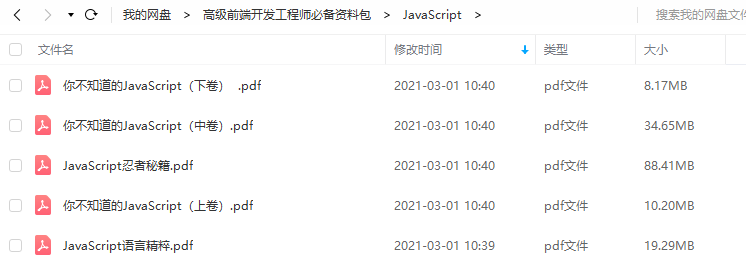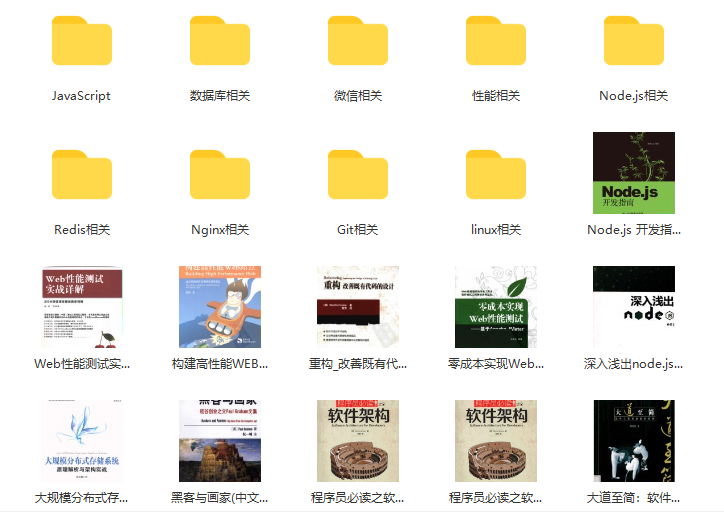文末
我一直觉得技术面试不是考试,考前背背题,发给你一张考卷,答完交卷等通知。
首先,技术面试是一个 认识自己 的过程,知道自己和外面世界的差距。
更重要的是,技术面试是一个双向了解的过程,要让对方发现你的闪光点,同时也要 试图去找到对方的闪光点,因为他以后可能就是你的同事或者领导,所以,面试官问你有什么问题的时候,不要说没有了,要去试图了解他的工作内容、了解这个团队的氛围。
前端面试题汇总

JavaScript
开源分享:【大厂前端面试题解析+核心总结学习笔记+真实项目实战+最新讲解视频】

性能

linux

前端资料汇总

let {x, y} = {x: 1, y: 2};
* JSON中的尾后逗号
JSON中不允许出现尾后逗号
JSON.parse(“[1, 2, 3,]”) // ❌
JSON.parse(‘{“a”: 1,}’) // ❌
JSON.parse(“[1, 2, 3]”) // ✅
JSON.parse(‘{“a”: 1}’) // ✅
### 六、`String.prototype.padStart()`
#### 6.1 定义
`padStart()` 用另一个字符串填充当前字符串。
#### 6.2 返回值
在原字符串**开头**填充指定的填充字符串直到目标长度所形成的新字符串。
#### 6.3 语法
str.padStart(targetLength);
str.padStart(targetLength, padString);
* targetLength:当前字符串需要填充到的目标长度。如果这个数值小于当前字符串的长度,则返回当前字符串本身。
* padString(可选):填充字符串。如果字符串太长,使填充后的字符串长度超过了目标长度,则只保留最左侧的部分,其他部分会被截断。此参数的默认值为 " "。
#### 6.4 例子
‘abc’.padStart(10); // " abc"
‘abc’.padStart(10, “foo”); // “foofoofabc”
‘abc’.padStart(6,“123465”); // “123abc”
‘abc’.padStart(8, “0”); // “00000abc”
‘abc’.padStart(1); // “abc”
### 七、`String.prototype.padEnd()`
#### 7.1 定义
padEnd() 方法会用一个字符串填充当前字符串(如果需要的话则重复填充)。
#### 7.2 返回值
返回在原字符串**末尾**填充指定的填充字符串直到目标长度所形成的新字符串。
#### 7.3 语法
str.padEnd(targetLength)
str.padEnd(targetLength, padString)
* targetLength:当前字符串需要填充到的目标长度。如果这个数值小于当前字符串的长度,则返回当前字符串本身。
* padString(可选):填充字符串。如果字符串太长,使填充后的字符串长度超过了目标长度,则只保留最左侧的部分,其他部分会被截断。此参数的缺省值为 " "。
#### 7.4 例子
‘abc’.padEnd(10); // "abc "
‘abc’.padEnd(10, “foo”); // “abcfoofoof”
‘abc’.padEnd(6, “123456”); // “abc123”
‘abc’.padEnd(1); // “abc”
## ES9
ES2018(ES9)新增了如下特性👇
* `Async iterators` 异步迭代器
* `Object rest properties` 剩余属性
* `Object spread properties` 扩展属性
* `Promise.prototype.finally`
### 一、`Async iterators` 异步迭代器
#### 1.1 返回值
`Async iterator` 对象的 next() 方法返回一个 `Promise`,这个 `Promise` 的返回值可以被解析成 `{value, done}` 的格式,
#### 1.2 语法
iterator.next().then(({value, done}) => {});
#### 1.3 举例
const asyncIterator = () => {
const array = [1, 2];
return {
next: function() {
if(array.length) {
return Promise.resolve({
value: array.shift(),
done: false
});
}
return Promise.resolve({
done: true
});
}
}
}
let iterator = asyncIterator();
const test = async() => {
await iterator.next().then(console.log); // {value: 1, done: false}
await iterator.next().then(console.log); // {value: 2, done: false}
await iterator.next().then(console.log); // {done: true}
}
test();
#### 1.4 可以使用 `for-await-of` 在循环中异步调用函数
const promises = [
new Promise((resolve) => resolve(1)),
new Promise((resolve) => resolve(2)),
new Promise((resolve) => resolve(3)),
];
const test = async() => {
for await (const p of promises) {
console.log(‘p’, p);
}
};
test();
### 二、`Object rest properties`
#### 2.1 举例
let test = {
a: 1,
b: 2,
c: 3,
d: 4
}
let {a, b, …rest} = test;
console.log(a); // 1
console.log(b); // 2
console.log(rest); // {c: 3, d: 4}
#### 2.2 注意
* `null` 不能使用扩展运算符
let {a, b, …rest} = null; // ❌
### 三、`Object spread properties`
#### 3.1 举例
let test = {
a: 1,
b: 2
}
let result = {c: 3, …test};
console.log(result); // {c: 3, a: 1, b: 2}
let test = null;
let result = {c: 3, …test}; // {c: 3}
### 四、`Promise.prototype.finally`
#### 4.1 定义
在`Promise`结束的时候,不管是结果是`resolved`还是`rejected`,都会调用`finally`中的方法
`finally`中的回调函数不接受任何参数
#### 4.2 返回值
一个Promise
#### 4.3 语法
const promise = new Promise((resolve, reject) => {
resolve(‘resolved’);
reject(‘rejectd’);
})
promise.then((res) => {
console.log(res);
}).finally(() => {
console.log(‘finally’)
});
#### 4.4 举例
const promise = new Promise((resolve, reject) => {
resolve(1);
reject(2);
});
const test = () => {
console.log(3);
promise.then((res) => {
console.log(4, res);
}).catch(err => {
console.log(5, err);
}).finally(() => {
console.log(6);
});
};
test(); // 3 4 1 6
## ES10
ES2019(ES10)新增了如下新特性👇:
* `Array.prototype.{flat, flatMap}`扁平化嵌套数组
* `Object.fromEntries`
* `String.prototype.{trimStart, trimEnd}`
* `Symbol.prototype.description`
* `Optional catch binding`
* Array.prototype.sort() is now required to be stable
### 一、`Array.prototype.{flat, flatMap}` 扁平化嵌套数组
#### 1.1 Array.prototype.flat
1.1.1 定义
`flat()`方法会按照一个可指定的深度遍历递归**数组**,并将所有元素与遍历到的子数组中的元素合并为一个新数组返回。
1.1.2 语法
arr.flat([depth]);
* `depth` 是数组遍历的深度,默认是1。
1.1.3 返回值
一个新数组,不会改变旧数组。
1.1.4 举例
const arr = [1, 2, [[[[3, 4]]]]];
arr.flat(); // [1, 2, [[[3, 4]]]]
arr.flat(3); // [1, 2, [3, 4]]
arr.flat(-1); // [1, 2, [[[[3, 4]]]]]
arr.flat(Infinity); // [1, 2, 3, 4]
1.1.5 注意
* `flat()`会移除数组中的空项
let arr = [1, 2, , , 3];
arr.flat(); // [1, 2, 3]
1.1.6 替换
* `reduce`与`contact`
let arr = [1, 2, [3, 4]];
arr.reduce((arr, val) => arr.concat(val), []);
* `...` 扩展运算符与`contact`
let arr = [1, 2, [3, 4]];
[].contact(…arr);
[更多替换方式请查看MDN](https://bbs.csdn.net/topics/618166371)
#### 1.2 Array.prototype.flatMap
1.2.1 定义
`flatMap()`方法首先使用映射函数映射数组(**深度值为1**)的每个元素,然后将结果压缩成一个新数组。
1.2.2 返回值
一个新数组,并且每个元素都是回调函数的结果。
1.2.3 语法
arr.flatMap(function callback(currentVal[, index[, array]]) {
}[, thisArg])
* callback: 可以生成一个新数组所调用的函数
+ currentVal: 当前数组在处理的元素
+ index: 可选,正在处理的元素索引
+ array: 可选,被调用的数组
* thisArg: 执行callback函数时使用的this值
1.2.4 举例
let arr = [‘My name’, ‘is’, ‘’, ‘Lisa’];
let newArr1 = arr.flatMap(cur => cur.split(’ ‘));
let newArr2 = arr.map(cur => cur.split(’ '));
console.log(newArr1); // [“My”, “name”, “is”, “”, “Lisa”]
console.log(newArr2); // [[“My”, “name”], [“is”], [“”], [“Lisa”]]
### 二、`Object.fromEntries`
#### 2.1 定义
`fromEntries()` 方法会把键值对列表转换成一个对象
#### 2.2 返回值
一个新的对象
#### 2.3 语法
Object.fromEntries(iterable)
* iterable: Array、Map等可迭代对象
#### 2.4 举例
let map = new Map([[‘a’, 1], [‘b’, 2]]);
let mapToObj = Object.fromEntries(map);
console.log(mapToObj); // {a: 1, b: 2}
let arr = [[‘a’, 1], [‘b’, 2]];
let arrToObj = Object.fromEntries(arr);
console.log(arrToObj); // {a: 1, b: 2}
let obj = {a: 1, b: 2};
let newObj = Object.fromEntries(
Object.entries(obj).map(
([key, val]) => [key, val * 2]
)
);
console.log(newObj); // {a: 2, b: 4}
### 三、`String.prototype.{trimStart, trimEnd}`
#### 3.1 `String.prototype.trimStart`
3.1.1 定义
`trimStart()` 方法用来删除字符串的开头的空白字符。
`trimLeft()` 是它的别名。
3.1.2 返回值
一个新的字符串,这个字符串左边的空格已经被去除掉了。
3.1.3 语法
str.trimStart();
str.trimLeft();
3.1.4 🌰 举例
let str = ’ a b cd ';
str.trimStart(); // 'a b cd ’
str.trimLeft(); // 'a b cd ’
#### 3.2 `String.prototype.trimEnd`
3.2.1 定义
`trimEnd()` 方法用来删除字符串末尾的空白字符。 `trimRight()` 是它的别名
3.2.2 返回值
一个新的字符串,这个字符串右边的空格已经被去除了
3.2.3 语法
str.trimEnd()
str.trimRight()
3.2.4 举例
let str = ’ a b cd ‘;
str.trimEnd(); // ’ a b cd’
str.trimRight(); // ’ a b cd’
### 四、`Symbol.prototype.description`
#### 4.1 定义
`description` 是一个只读属性
#### 4.2 返回值
它返回Symbol对象的可选描述的字符串
#### 4.3 语法
Symbol(‘myDescription’).description;
Symbol.iterator.description;
Symbol.for(‘foo’).description;
#### 4.4 举例
Symbol(‘foo’).description; // ‘foo’
Symbol().description; // undefined
Symbol.for(‘foo’).description; // ‘foo’
### 五、`Optional catch binding`
可选的捕获绑定,允许省略catch绑定和它后面的圆括号
以前的用法:
try {
} catch(err) {
console.log(‘err’, err);
}
ES10 的用法:
try {
} catch {
}
### 六、`JSON.stringify()` 的增强力
`JSON.stringify()` 在 ES10 修复了对于一些超出范围的 Unicode 展示错误的问题,所以遇到 0xD800-0xDFF 之内的字符会因为无法编码成 UTF-8 进而导致显示错误。在 ES10 它会用转义字符的方式来处理这部分字符而非编码的方式,这样就会正常显示了。
JSON.stringify(‘😊’); // ‘“😊”’
### 七、修订 `Function.prototype.toString()`
以前的 toString 方法来自 `Object.prototype.toString()`,现在 的 `Function.prototype.toString()` 方法返回一个表示当前函数源代码的字符串。以前只会返回这个函数,不会包含空格、注释等。
function foo() {
// es10新特性
console.log(‘imooc’)
}
console.log(foo.toString());
// function foo() {
// // es10新特性
// console.log(‘imooc’)
// }
## ES11
ES2020(ES11)新增了如下新特性👇:
* 空值合并运算符(Nullish coalescing Operator)
* 可选链 Optional chaining
* globalThis
* BigInt
* `String.prototype.matchAll()`
* `Promise.allSettled()`
* Dynamic import(按需 import)
### 一、空值合并运算符(Nullish coalescing Operator)
#### 1.1 空值合并操作符(`??`)
**空值合并操作符**(`??`)是一个逻辑操作符,当左边的操作数为 `null` 或 `undefined` 的时候,返回其右侧操作符,否则返回左侧操作符。
undefined ?? ‘foo’ // ‘foo’
null ?? ‘foo’ // ‘foo’
‘foo’ ?? ‘bar’ // ‘foo’
#### 1.2 逻辑或操作符(`||`)
**逻辑或操作符**(`||`),会在左侧操作数为假值时返回右侧操作数,也就是说如果使用 `||` 来为某些变量设置默认值,可能会出现意料之外的情况。比如 0、''、NaN、false:
0 || 1 // 1
0 ?? 1 // 0
‘’ || ‘bar’ // ‘bar’
‘’ ?? ‘bar’ // ‘’
NaN || 1 // 1
NaN ?? 1 // NaN
false || ‘bar’ // ‘bar’
false ?? ‘bar’ // false
#### 1.3 注意
不可以将 `??` 与 AND(`&&`)OR(`||`)一起使用,会报错。
null || undefined ?? “foo”; // 抛出 SyntaxError
true || undefined ?? “foo”; // 抛出 SyntaxError
### 二、可选链 Optional chaining
#### 2.1 介绍
**可选链操作符**(`?.`)允许读取位于连接对象链深处的属性的值,而不必明确验证链中的每个引用都是否有效。`?.` 操作符的功能类似于`.`链式操作符,不同之处在于,在引用为 `null` 或 `undefined` 时不会报错,该链路表达式返回值为 `undefined`。
以前的写法:
const street = user && user.address && user.address.street;
const num = user && user.address && user.address.getNum && user.address.getNum();
console.log(street, num);
ES11 的写法:
const street2 = user?.address?.street;
const num2 = user?.address?.getNum?.();
console.log(street2, num2);
#### 2.2 注意
可选链不能用于赋值:
let object = {};
object?.property = 1; // Uncaught SyntaxError: Invalid left-hand side in assignment
### 三、globalThis
以前,在 Web 中,可以通过 `window`、`self` 取到全局对象,在 node.js 中,必须使用 `global`。
在松散模式下,可以在函数中返回 `this` 来获取全局对象,但是在严格模式和模块环境下,`this` 会返回 `undefined`。
以前要获取全局对象,可以定义一个函数:
const getGlobal = () => {
if (typeof self !== ‘undefined’) {
return self
}
if (typeof window !== ‘undefined’) {
return window
}
if (typeof global !== ‘undefined’) {
return global
}
throw new Error(‘无法找到全局对象’)
}
const globals = getGlobal()
console.log(globals)
现在 `globalThis` 提供了一个标准的方式来获取不同环境下的全局对象自身值。
### 四、BigInt
BigInt 是一种内置对象,用来创建比 2^53 - 1(Number 可创建的最大数字) 更大的整数。可以用来表示任意大的**整数**
#### 4.1 如何定义一个 BigInt
* 在一个整数字面量后面加 n,例如 `10n`
* 调用函数 `BigInt()` 并传递一个整数值或字符串值,例如 `BigInt(10)`
#### 4.2 BigInt 的特点
* BigInt 不能用于 Math 对象中的方法;
* BigInt 不能与任何 Number 实例混合运算,两者必须转换成同一种类型。但是需要注意,BigInt 在转换成 Number 时可能会丢失精度。
* 当使用 BigInt 时,带小数的运算会被向下取整
* BigInt 和 Number 不是严格相等,但是宽松相等
0n === 0 // false
0n == 0 // true
* BigInt 和 Number 可以比较
2n > 2 // false
2n > 1 // true
* BigInt 和 Number 可以混在一个数组中排序
const mixed = [4n, 6, -12n, 10, 4, 0, 0n];
mixed.sort(); // [-12n, 0, 0n, 10, 4n, 4, 6]
* 被 Object 包装的 BigInt 使用 object 的比较规则进行比较,只用同一个对象比较时才相等
0n === Object(0n); // false
Object(0n) === Object(0n); // false
const o = Object(0n);
o === o // true
#### 4.3 BigInt 的方法
4.3.1 BigInt.asIntN()
将 BigInt 值转换为一个 -2^(width-1) 与 2^(width-1) - 1 之间的有符号整数。
4.3.2 BigInt.asUintN()
将一个 BigInt 值转换为 0 与 2^(width) - 1 之间的无符号整数。
4.3.3 BigInt.prototype.toLocaleString()
### 文末
我一直觉得技术面试不是考试,考前背背题,发给你一张考卷,答完交卷等通知。
首先,技术面试是一个 认识自己 的过程,知道自己和外面世界的差距。
更重要的是,技术面试是一个双向了解的过程,要让对方发现你的闪光点,同时也要 试图去找到对方的闪光点,因为他以后可能就是你的同事或者领导,所以,面试官问你有什么问题的时候,不要说没有了,要去试图了解他的工作内容、了解这个团队的氛围。
**前端面试题汇总**

**JavaScript**
**[开源分享:【大厂前端面试题解析+核心总结学习笔记+真实项目实战+最新讲解视频】](https://bbs.csdn.net/topics/618166371)**

**性能**

**linux**

**前端资料汇总**























 489
489











 被折叠的 条评论
为什么被折叠?
被折叠的 条评论
为什么被折叠?








